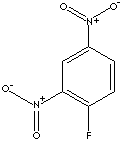PRODUCT IDENTIFICATION

H.S. CODE
TOXICITY
CLASSIFICATION
PHYSICAL AND CHEMICAL PROPERTIES
178 C
1.475 - 1.485
AUTOIGNITION
NFPA RATINGS
REFACTIVE INDEX
APPLICATIONS
- Michael addition
- Reduction
- Henry Reaction (Nitro-aldol reaction)
- Nef reaction
- O-Alkylation
- Cycloaddition
- Substitution, Elimination, Conversion reaction
- Alkylation, Acylation, and Halogenation
2,4-Dinitrofluorobenzene is used as an intermediate for the synthesis of pesticides and pharmaceuticals such as flurbiprofen (nonsteroidal anti-inflammatory agent). It is used as a reagent ( Sanger's reagent) to identify the terminal amino acids in a protein chain and to detection of phenols.
APPEARANCE
ASSAY
99.0% min
40kgs in Drum
GENERAL DESCRIPTION OF NITROBENZENE
Nitrobenzene (also called nitrobenzol ) is a colourless to pale yellow, oily, highly toxic liquid with the odour of bitter almonds. Nitrobenzene is manufactured commercially by nitration of benzene (also a common air pollutant) using a mixture of nitric and sulfuric acids. Commercially nitrobenzene can be either produced in a batch or by a continuous process. Both batch and continuous processes employing mixed nitric and sulfuric acids are used to make nitrobenzene. The continuous process is favored over the batch process because its production capacity is much larger, it has lower capital costs and it entails more efficient labor usage. Reactors for the continuous process also usually utilized lower nitric acid concentrations, are smaller with more rapid and efficient mixing, and therefore have higher reaction rates. Nitrobenzene undergoes nitration, halogenation, and sulfonation much more slowly than does benzene. It may be reduced to a variety of compounds, depending on the reaction conditions. Most nitrobenzene produced is reduced to aniline smaller amounts are converted to azobenzene, hydrazobenzene (the intermediate for benzidine), and phenylhydroxylamine. Reduction of both the nitro group and the benzene ring affords cyclohexylamine. Nitrobenzene is used as a mild oxidizing agent in the syntheses of quinoline and fuchsin. Nitrobenzene is used to produce lubricating oils such as those used in motors and machinery. Nitrobenzene and its derivatives are used in the manufacture of dyes, drugs, pesticides, polisher, paint, and synthetic rubber.